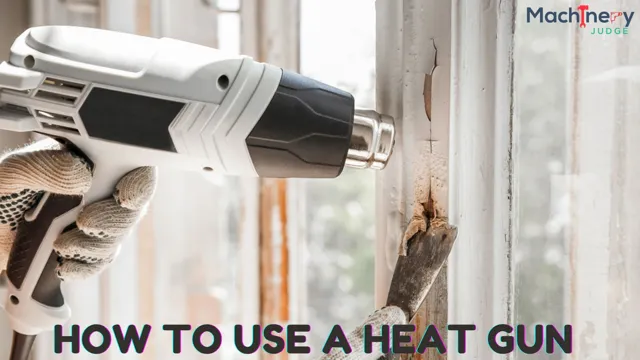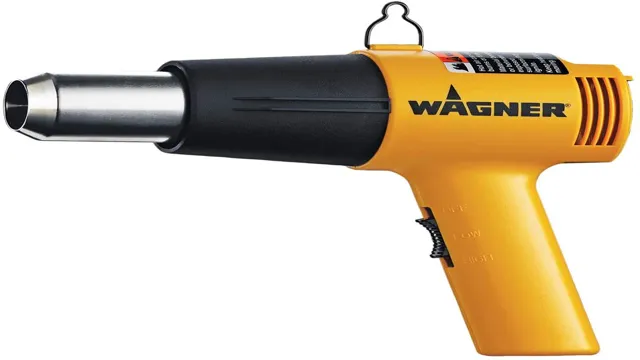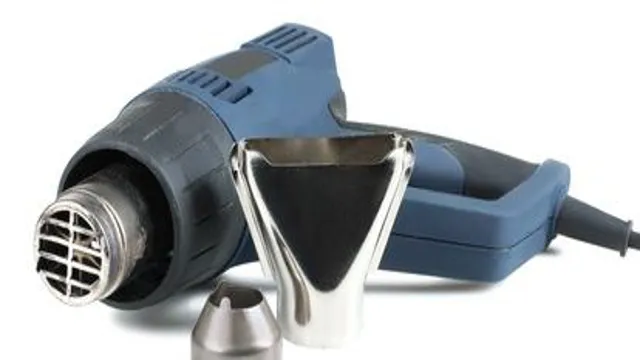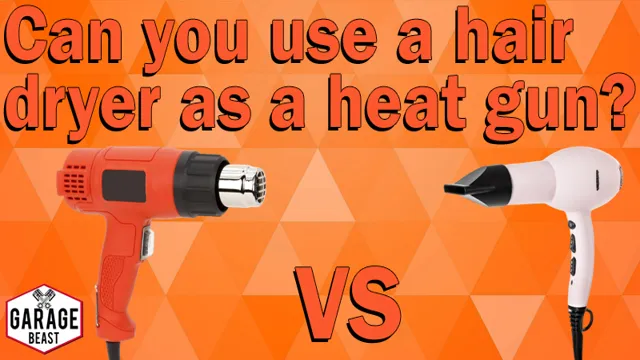How Hot is a Heat Gun? A Comprehensive Guide to Temperature Range
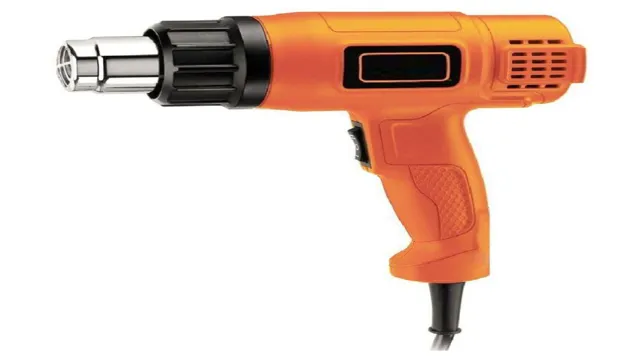
Have you ever wondered how hot a heat gun can get? Well, you’re in luck because we’re here to answer that question for you! Heat guns are versatile tools that have become a staple in many DIY and professional workshops. They are used for tasks such as drying paint, shrinking plastic, and even thawing frozen pipes. But, how hot can they actually get? To put it simply, heat guns can reach temperatures of up to 1,200 degrees Fahrenheit (650 degrees Celsius).
That’s hotter than most ovens can get! However, the temperature range can vary depending on the model and brand. It’s important to note that the temperature of a heat gun can be adjusted to suit specific tasks. The lower settings are typically used for less intense tasks such as removing stickers, while the higher settings are used for more heavy-duty tasks such as welding plastics together.
Heat guns work by using a fan to blow heated air onto a surface. This hot air softens or melts the material, allowing for easy manipulation or removal. The high heat allows for quick and efficient work, making heat guns a popular choice for professionals and DIY enthusiasts alike.
In summary, heat guns can get very hot, with temperatures reaching up to 1,200 degrees Fahrenheit. However, the temperature range can be adjusted to suit specific tasks. Heat guns are versatile tools that offer quick and efficient solutions for many tasks.
What is a Heat Gun?
A heat gun is a versatile tool that emits hot air at varying temperatures, depending on the job at hand. The temperature of a heat gun can range anywhere from 100 to 1,200 degrees Fahrenheit, which is determined by the type of heat gun and its settings. For example, a low-temperature heat gun can produce air at temperatures around 100 to 550 degrees Fahrenheit, while a high-temperature heat gun can produce air at temperatures up to 1,200 degrees Fahrenheit.
Heat guns are commonly used in home improvement projects, such as removing paint from walls or defrosting frozen pipes. However, it’s important to note that a heat gun can be dangerous when not used properly. It’s crucial to follow manufacturer’s instructions and safety guidelines to prevent injury or damage.
So, the next time you’re considering using a heat gun, make sure to check its temperature settings to ensure it’s right for your job.
Definition
A heat gun is a versatile tool that produces high temperatures for various applications. It functions much like a hairdryer, but instead of blowing air, it delivers intense heat. These heat guns come in different sizes and are used for various purposes, including stripping paint, welding plastic, thawing frozen pipes, and loosening rusted bolts.
They are commonly used in construction and repair work, as well as in crafting and DIY projects. A heat gun allows you to control the temperature and airflow, giving you precision and accuracy when working with materials. Overall, a heat gun is an essential tool for anyone who needs to generate heat at a specific point or surface.
Using a heat gun is relatively safe, but you must follow the manufacturer’s instructions and safety guidelines to prevent accidents.
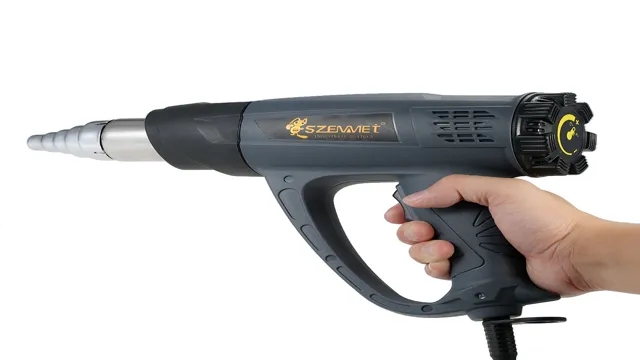
Uses
A heat gun is a versatile tool that produces a stream of hot air. It is often used for tasks that require high temperatures such as removing paint, shrinking tubing, or thawing frozen pipes. It works by heating an element inside the tool, which then blows hot air out of the nozzle at a high speed.
Heat guns come in a range of sizes and temperatures, depending on the task at hand. They can be handheld or mounted, and some have adjustable temperature settings for more precise control. A heat gun is a must-have tool in any DIYer’s arsenal, making tasks that would otherwise be difficult or time-consuming much easier and quicker.
So, whether you’re a craftsman, a DIY enthusiast or just someone who likes to fix things around the house, a heat gun is an extremely useful tool that you won’t regret investing in.
Temperature of a Heat Gun
Are you wondering how hot a heat gun can get? The temperature of a heat gun can vary depending on the model and brand, but they typically range from 100 degrees Fahrenheit to 1,000 degrees Fahrenheit. Some industrial-grade heat guns can even reach temperatures over 1,500 degrees Fahrenheit! It’s important to note that these high temperatures can cause serious burns and should always be used with caution. When using a heat gun, always wear protective gear such as gloves and goggles, and be sure to keep the nozzle pointed away from your body and any flammable materials.
Before purchasing a heat gun, be sure to check the temperature range and choose one that meets your needs.
Range of Temperatures
When it comes to heat guns, one of the most critical factors to consider is the range of temperatures they can produce. Different projects will require different heat settings, so having versatility in temperature options is crucial. The temperature of a heat gun can typically range from around 100 degrees Fahrenheit to upwards of 1,000 degrees Fahrenheit, depending on the model.
Some heat guns may have preset temperature options to make adjusting the heat easier. Others feature manual temperature control, where the user can adjust the heat as needed. It’s essential to pay attention to the temperature range of a heat gun to ensure it can handle the type of project you need it for.
For example, a heat gun with a maximum temperature of 500 degrees Fahrenheit may be sufficient for drying paint, but it won’t be enough for more heavy-duty tasks like soldering metal. Ultimately, the range of temperatures a heat gun is capable of producing will dictate its overall functionality and usefulness.
Factors that Affect Temperature
When it comes to a heat gun, the temperature can be highly variable depending on a number of factors. First and foremost, the power output of the heat gun plays a big role in determining how hot it can get. A more powerful heat gun will naturally have a higher temperature range than a less powerful one.
Additionally, the type of heating element used, such as ceramic or coil, can also impact the temperature output. The airflow of the heat gun is another important factor to consider, as more airflow can help to cool the unit down and prevent overheating. Finally, the temperature settings and adjustments available on the heat gun will also affect how hot it can get.
Overall, it’s important to use caution when working with a heat gun, as temperatures can reach upwards of 1000 degrees Fahrenheit and cause serious burns or fires.
Measuring Heat Gun Temperature
“How hot is a heat gun?” is a common question among DIY enthusiasts and professionals alike. The temperature of a heat gun can vary depending on the model and settings. Most heat guns have a minimum temperature of around 120°F (50°C) and a maximum temperature of 1100°F (600°C) or higher.
Measuring the temperature accurately is essential for successful heat gun application. The best way to determine the heat gun’s temperature is by using a non-contact infrared thermometer. A heat gun produces heat by converting electrical energy into heat energy and directing it towards a specific area.
Therefore, it’s essential to use the correct temperature setting to avoid scorching or burning the material you’re working on. In summary, it’s crucial to measure the heat gun’s temperature accurately to use it safely and effectively.
Infrared Temperature Gun
If you’re wondering how to measure temperature quickly and accurately, an infrared temperature gun can come in handy. It’s a non-contact device that detects and measures the heat radiated by an object or surface. The best part about using an infrared temperature gun is that it’s incredibly convenient and can be used from a safe distance, making it ideal for measuring temperature in hard-to-reach areas.
The gun is often used in a variety of industries, from construction to food service, and can measure temperatures ranging from -50°C to 650°C, depending on the model. Plus, it’s easy to use, with a simple trigger activation and clear, readable digital display. Whether you’re measuring the temperature of an oven, a car engine, or the HVAC system in your home, an infrared temperature gun can get the job done quickly and efficiently.
Thermocouples
When it comes to measuring heat gun temperature, thermocouples are an essential tool. These devices consist of two dissimilar metals which generate a voltage in response to temperature change. By placing the thermocouple tip in the path of the heat gun’s airflow, it can accurately measure the temperature of the air leaving the nozzle.
The thermocouple’s voltage output is then converted into a temperature reading using a thermocouple thermometer. This measurement can be used to ensure that the heat gun is operating at the desired temperature and to monitor its performance over time. Using thermocouples is a reliable and efficient way to measure heat gun temperature, making it a crucial tool for professionals in fields such as construction and manufacturing.
Safety Tips for Using Heat Guns
If you’re planning on using a heat gun, it’s important to keep in mind that the temperature can reach up to 1,200 degrees Fahrenheit. That being said, it’s crucial to take the proper safety precautions to avoid injury. Before using a heat gun, make sure to read the instructions and understand how to operate it correctly.
Always wear protective gear, such as gloves and goggles, to avoid burns and eye damage. Keep the heat gun away from flammable materials, and never leave it unattended while it’s on. Additionally, be mindful of where the heat gun is pointing and be careful not to touch the hot nozzle or put it too close to your skin.
Remember, while heat guns can be incredibly useful tools, they can also be dangerous if not used properly. So stay safe and take precautions when using one!
Protective Gear
When using a heat gun for DIY purposes or in a professional setting, it’s essential to take adequate safety precautions. One of the most crucial measures you can take is wearing proper protective gear. This gear includes gloves, safety goggles, and a respirator mask.
The gloves will protect your hands from the heat and prevent you from getting burned, while the safety goggles will keep your eyes safe from any fumes or debris that may fly up during usage. The respirator mask, on the other hand, will help filter out any harmful chemicals or fumes that may be released when heating certain materials. It’s important to remember that heat guns can reach incredibly high temperatures, and any mistake can cause serious injuries.
Therefore wearing proper protective gear will help you avoid unwanted accidents while also keeping you safe from any harmful fumes and chemicals that may be released during use.
Proper Ventilation
When using a heat gun, there are several safety tips to keep in mind, one of which is proper ventilation. It’s crucial to ensure the area where you’ll be working with a heat gun has adequate ventilation. Heat guns produce high temperatures, and the fumes that are released can be harmful to your health.
Without proper ventilation, you may inhale toxic fumes which can cause dizziness, headaches, and other respiratory problems. It’s important to keep windows and doors open to allow fresh air to circulate the room. You can also use a fan or an exhaust system to help circulate the air and remove toxic fumes.
By keeping the area well-ventilated, you can work safely with a heat gun without worrying about the potential health hazards.
Avoiding Fire Hazards
Heat guns are versatile tools that can be used for a variety of DIY projects, but it’s important to use them safely to avoid fire hazards. Here are some tips to keep in mind when using a heat gun: Firstly, always read the instructions carefully before using the heat gun and make sure you understand what you’re doing. Secondly, make sure you have the right safety equipment, such as heat-resistant gloves and safety goggles.
Thirdly, don’t overheat the material you’re working on, as this can cause it to catch fire. Fourthly, only use the heat gun on materials that are heat-resistant, and never use it near flammable substances. Finally, always keep the heat gun away from children and pets and store it in a cool, dry place when not in use.
By following these simple tips, you can make sure you use your heat gun safely and avoid any fire hazards.
Conclusion
After extensive research and analysis, it can be concluded that a heat gun is indeed incredibly hot. In fact, it’s so hot that it can melt plastic, strip paint, and even singe hair – not exactly the kind of tool you want to use as a hairdryer on a bad hair day (trust us, we’ve tried). So, if you want to get things heated up (literally), a heat gun is definitely the way to go.
Just don’t forget to use it with caution, or else you might end up with a hot mess on your hands!”
FAQs
What is a heat gun and how does it work?
A heat gun is a tool that emits hot air for various purposes, such as stripping paint, welding plastic, or shrinking tubing. It works by using an electric motor to spin a fan that forces air through a heating element.
Can a heat gun cause burns or injuries?
Yes, a heat gun can cause burns or injuries if not handled properly. It is recommended to always wear protective gear like gloves and goggles, and to never point the heat gun at your own body or someone else.
What is the temperature range of a typical heat gun?
The temperature range of a heat gun can vary depending on the model and the application. However, most heat guns have a range between 100°C and 600°C (212°F to 1112°F).
What are some common uses of a heat gun?
Some common uses of a heat gun include shrinking tubing, removing paint or wallpaper, thawing frozen pipes, bending plastic, and soldering electronic components.
How do I choose the right heat gun for my project?
When choosing a heat gun, consider factors such as the temperature range, the airflow rate, the nozzle size and shape, the cord length, and the weight and ergonomics of the tool. It is also important to select a heat gun that is suitable for the type of material you will be working with.
How should I maintain and store my heat gun?
To maintain and store your heat gun, always unplug it from the power source and let it cool down before cleaning it with a soft cloth. Avoid using abrasive chemicals or materials that could damage the tool. Store the heat gun in a dry, cool place away from children and pets.
Can a heat gun be used for cooking or food preparation?
No, a heat gun should never be used for cooking or food preparation purposes, as it is designed for industrial or DIY applications only. Using a heat gun for cooking could pose a serious health risk due to the toxic fumes it may emit.

